How can you get China SIM cards? And which China SIM card is best? While some travelers have the option to activate the international roaming on their home country phone plans, that’s either really expensive or not a good option for those who will be in China long-term. The best solution is to get your own Chinese SIM card. Here’s how.
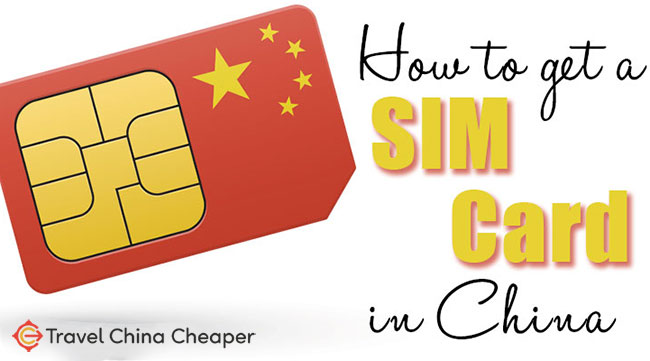
Having traveled around Asia for over 15 years, I highly recommend traveling through China with a smartphone.
You can get map directions, pay for almost anything, use Chinese voice translators, use the popular WeChat app, book Chinese trains, and so much more. In short, your smart phone can take all the most common pains out of traveling so you can focus more on having a good time.
But to do all these things, you need network access for your phone, which often requires buying a local SIM card. A local SIM card is not only cost-efficient but also provides reliable connectivity, allowing easier access to essential services and applications widely used in China.
For those who may not know, a SIM card (short for “subscriber identity module”) is that little card that goes inside your phone that connects you to local service (phone, text, internet). You may not know it’s there…but it is.
Newer phones now have the option to use what’s known as an eSIM, which is a digital version of this small card. However, be aware that certain mobile networks, such as China Telecom, may not support many international phones, particularly those from Europe and North America, due to variations in frequency bands and technology standards.
Overall I recommend three ways to connect to China’s mobile network using your phone:
- Purchase a PrePaid SIM Card: If you know for sure that your phone is unlocked, you can purchase a Chinese SIM card (or eSIM card) prior to your arrival in China.
- Purchase a SIM Card in China: If you’re already in China or if it’s too late to purchase a prepaid China SIM card, you can always visit the office of a local service provider in China to get a SIM card. This option takes time, however, so I wouldn’t make this your primary option.
- Rent a Phone / International Roaming: If your phone isn’t unlocked but you still need to use a phone in China, you can either rent a phone or use international roaming with your home carrier.
Before I go on about SIM cards, it’s worth noting that if all you need is internet access, you can always look into your options for getting reliable WiFi in China. There are drawbacks to this method, but in some ways it is easier than trying to get a China SIM card.
Table of Contents
In order to better understand how to use your mobile phone internationally or how China treats cellular customers, let’s start off with some basics of Chinese SIM cards.
Note: Some links in this article are affiliate links, which means that at no extra cost to you, I may be compensated if you choose to use one of the services listed. I only recommend what I’ve personally used, and I appreciate your support!
Introduction to China Mobile Options
When traveling to China, staying connected is essential for navigation, communication, and accessing important information. With the rise of mobile technology, China has become a hub for mobile innovation, offering a wide range of mobile options for tourists and locals alike. In this section, we will introduce you to the various China mobile options available, including prepaid SIM cards, eSIMs, and physical SIM cards.
Whether you’re a tourist or a business traveler, having reliable mobile data and internet access can make your trip smoother and more enjoyable. China mobile options are designed to cater to different needs, from short-term tourist SIM cards to long-term local prepaid SIM cards. These options provide flexibility and convenience, ensuring you stay connected throughout your journey.
The Basics – Using a China SIM Card
Although using a SIM card with any phone is generally as easy as inserting it in your phone (or the 5-minute setup process for an eSIM), there are a couple basic -but incredibly important! – things you should know before buying one for China.
Let’s run through the most important ones. A prepaid Chinese SIM card is a convenient option, allowing you to have immediate connectivity upon arrival. These SIM cards can be purchased online before your trip, and you will need your passport for the necessary documentation. Understanding the specific coverage and functionality offered by different carriers is also crucial.
Your Phone Must Be Unlocked for a new SIM (IMPORTANT!)
First thing to know is that your phone needs to be unlocked to use a China SIM card.
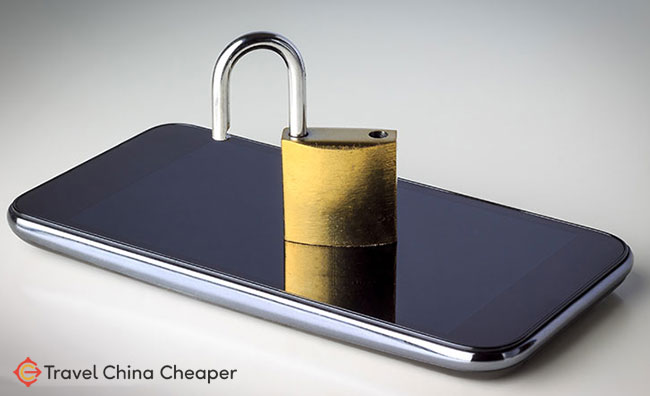
If you purchased your phone at a discount (e.g. AT&T or Verizon subsidized the phone or gave it to you “free”), or you currently lease your phone, it’s likely your phone is locked by your carrier. This means you won’t be able to take advantage of the cost efficiency and benefits of local SIM cards, such as stable high-speed connectivity and having a local contact number.
Unfortunately, if this is the case you can’t use a China SIM card.
Note on Locked Phones
This isn’t the case for phones that offer 2 SIM card slots or for eSIMs. In this case, you can still purchase a SIM or eSIM even if your phone is still locked to your home carrier.
Until you make a request to your carrier and in some cases pay off the balance of your phone entirely, that mobile phone will remain “locked” into that service provider.
Still not sure if your phone is unlocked?
If so, use one of the resources I list below to check if the phone is unlocked.
If it is, you can contact your phone carrier and explain you need the unlock code for your trip to China. As long as you don’t have any outstanding balances on your account, your wireless carrier generally will have zero objections to unlocking your phone.
Expect this process to take a few days, so plan ahead should your trip to China be coming up.
SIM Cards in China Expire with No Use
During my second trip to China, I was surprised to find out after landing that my previous phone plan no longer worked, despite having plenty of credit leftover from the previous trip.
This happened because Chinese phone providers cancel unused SIM cards after a certain amount of time (different for each carrier).
You’ll want to be careful not to buy your Chinese SIM card too far in advance.
Once you buy a prepaid China SIM card, it may only last 30 days upon activation. So time your purchase accordingly and request for your SIM card to activate on the day you land in China.
Remember to also only buy enough credit to last you for your trip. Even if you do revisit China, your leftover credit will likely be forfeited after 30 or 60 days.
Don’t worry, you can always top up your phone in China if you run out of credit.
You Must Register to Activate Your China SIM Card
The Chinese government requires real-name registration to activate a SIM card.
If you purchase a pre-paid Chinese SIM card before you leave (which I recommend), this means you usually have to provide a copy of your passport.
When buying a prepaid China SIM card, don’t be surprised when the company requires you to send in a photocopy of your passport. It’s an unavoidable part of the process to activate the SIM card.
If you purchase the SIM card within China, this could mean providing bio-metric data such as a face scan and fingerprints in addition to your passport.
Best China SIM Card (Recommendation)
Whether you’re purchasing a prepaid China SIM card before you arrive or you’ve decided to purchase a SIM card from within China at a local telecom office, it helps to know what’s available and which are the offers for the best China SIM card plan.
I’m always an advocate for things that make traveling in China easy. So my top pick for the best SIM card for China is one that can be easily purchased online prior to your arrival and that works with pretty many any phone that you might have. There are also specialised SIM card packages tailored specifically for tourists, offered by providers like China Mobile, China Unicom, and China Telecom. These packages ensure reliable and cost-effective mobile connectivity throughout your travels.
Airalo China eSIM Solution *Recommended*
Airalo is a popular eSIM provider that offers a range of data plans for China. Their eSIM solution is easy to set up and offers fast 4G speeds. With Airalo, you can choose from various data plans, including 1GB, 2GB, and 5GB options. Their eSIM is compatible with most devices, including iPhones and Samsung Galaxy phones.
The Airalo China eSIM is perfect for travelers who prioritize data over voice calls. It provides seamless internet access across mainland China, allowing you to stay connected without the need for a physical SIM card. The setup process is quick and straightforward, making it an excellent choice for those who want to hit the ground running upon arrival.
- eSIM Cards available for immediate use
- Data only (no phone number)
- Various data packages available
- Works all across China
- Available packages for 7, 15 and 30 days
For most people, having a phone number isn’t necessary when traveling. The only thing that matters is DATA. That’s why the Airalo China eSIM is such a good option.
There are multiple eSIMs to choose from, which include various options for validity (7 days, 15 days, or 30 days) as well as data limits (1GB up to 20GB).
Every Airalo eSIM offers coverage across every part of China and works immediately once you land in country. Unlimited data plans provide seamless internet access without the hassle of physical SIM cards, ensuring uninterrupted connectivity while traveling. Best of all, setting up an eSIM takes only about 10 minutes from the moment you click “purchase” to the moment when the eSIM is available to use.
Still, you’re going to want to get this set up prior to your visit to China, as well as downloading a good VPN for China
China Phone Plans (Purchased in China)
There are three major cellular providers in China:
- China Telecom
- China Unicom
- China Mobile
Unfortunately, China Telecom SIM cards don’t work with phones purchased outside of China, so even though you’ll see plenty of China Telecom stores in China, you’ll want to stick with either China Unicom or China Mobile.
While China Mobile is the market leader in China and generally has the best nationwide coverage, China Unicom is compatible with more foreign phones, allowing them to access both 3G and 4G service. That being said, I’ve used both services and had good experiences either way, so it’s hard to go wrong!
If you’re going to purchase a SIM card in China, here are my recommendations for the best China SIM card plan for each carrier. Prepaid SIMs are a great option as they typically include voice minutes alongside data, making them advantageous over eSIMs for travelers.
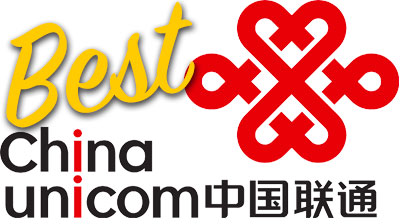
When visiting a China Unicom store, I’d go with the “Nationwide Data King” plan (全国流量王/ Quánguó liúliàng wáng). Here are the details for the plan:
- 69 RMB prepaid monthly
- 10 GB of nationwide data
- 500 minutes of outgoing nationwide calls
- Incoming calls and SMS text messages are free
- Additional outgoing calls are 0.15 RMB/minute
- Additional data charges are 10 RMB/100MB and 30 RMB /1GB

Most foreign phones won’t work with China Mobile’s 3G network, so you’ll be pushed to their 4G coverage where available (2G where not available). Here are the details for their best phone plan plan:
- 88 RMB prepaid monthly
- 10 GB of nationwide data coverage.
- 50 minutes of outgoing nationwide calls.
- Incoming calls and SMS text messages are free.
- Additional outgoing calls are 0.19 RMB/minute.
- Additional data slows down to 1 mbps until you top off your card.
In general, if you’re using a foreign phone, I recommend China Unicom over China Mobile.
Why?
China Unicom is most compatible with foreign phones and you can use both 4G and 3G service. I’ve also never experienced any real problems in service in major Chinese cities and their plans are really cheap for what you get!
China Mobile ranks #1 in coverage throughout China, but since their 3G service generally isn’t compatible with phones purchased outside of China, anywhere where there isn’t 4G coverage you’ll automatically get bumped down to the painfully slow 2G service.
DISCOUNTS: As with any business, you’ll often run into special promotions or discounts being offered in-store at both China Mobile and China Unicom. Sometimes these can be really good deals if you plan to be in China for a long while, but if your need of a China SIM card is short-term, it’s best to stick with the above recommended plans.
How to Top Up China SIM Cards
It’s quite possible that you encounter a point where they use up all your phone or data credit and cannot make outgoing calls, text messages, and lose the ability to access the Internet.
There are several ways for “topping up” your China SIM card when you run out of credit.
- Top Up At a Local Store. You can visit any one of your mobile carrier’s stores and give them your phone number and cash. They will take that as a hint that you need more credit added to your China SIM card. This method always works but, depending on the line, can take quite a while to accomplish.
- Top up through Alipay or WeChat Pay. While this is arguably the easiest and fastest way, you need a local Chinese bank account or money in your Alipay/WeChat Pay wallets to top up. If you don’t have a Chinese bank account, you can always hand a Chinese friend some cash and they can top up your Chinese SIM card for you.
I personally prefer topping up using Alipay or WeChat pay.

Using a Phone in China | 6 Crucial Tips
Finally, to maximize the use of your China SIM card or if you want to consider alternatives to buying a China phone plan entirely, I’ve got 6 crucial tips for you:
- Remember that China actively censors Internet content including websites and apps like Facebook, Instagram, YouTube, WhatsApp and many, many more blocked websites. So to share stories and photos with your friend during your journey, I’d buy a VPN before you leave to get around the Internet censors (such as ExpressVPN), otherwise it’s much harder to do so once you arrive since the VPN websites are blocked. Thankfully, there are still ways to install a VPN from within China.
- As mentioned above, the easiest way to buy a prepaid China SIM card before you depart for China. This can easily free up an entire morning or afternoon to see other things in China instead of waiting and trying to figure out phone plans. We recommend Airalo’s China eSIM options. A tourist SIM card offers the advantage of being tailored for travelers, often including data packages that suit short-term usage needs and simplifying the buying process compared to local alternatives.
- It can be easy to run out of phone credit quickly in China especially if you are consuming heavy data usage services like streaming and video chat. If you have a plan with less data than you would normally use at home, use your phone sparingly so you can avoid having to top off your phone plan multiple times.
- If all you need is Internet access and don’t see yourself needing to make any phone calls, consider instead renting or buying a global WiFi hotspot device for your trip.
- It’s no secret that the Chinese government monitors communication you send through WeChat and I for one do not like the idea of my passport tied to a China SIM card for privacy purposes. Even businesses restrict their own devices being used in China out of concerns for intellectual property theft, so I’d consider renting a phone for China during your trip. This is also a good option if your phone carrier won’t agree to unlock your phone.
- Lastly, you can always consider not dealing with the hassle of getting a China SIM card by using your own cellular provider in China. Keeping mind, though, that the international roaming charges can potentially run you a fortune. This option definitely wins for convenience, but can easily break the bank for budget travelers.
Benefits and Drawbacks of Using a Chinese SIM Card
Using a Chinese SIM card can be a cost-effective and convenient way to stay connected while traveling in China. Before you decide whether to use a Chinese SIM card or to pre-purchase an eSIM from something like Airalo, consider some of the benefits and drawbacks:
Benefits
- Works anywhere in China
- Usually a cheaper option
- Comes with a China phone number
- Allows access to local WiFi
Drawbacks
- Risk of giving China access to your device
- Sometimes a hassle to set up
Internet Censorship and VPNs in China
China has strict internet regulations, and some websites and apps may be blocked. To access unrestricted internet, you may need to use a VPN. Here are some things to consider:
- When using any kind of SIM card in China (local or foreign), China’s censorship applies
- If you want open access to the internet, it’s best to install a VPN before arriving in China
- It’s not just websites that are blocked in China…it’s likely you won’t be able to check your email as well
Final Thoughts | China SIM Card
As a seasoned traveler in China, I definitely think it’s worth having a local phone plan for your trip to China. Overall, I find buying one online easiest (especially a prepaid China SIM card) and there are many ways to top off your plan should you run out of credit.
If getting a SIM card is something you truly don’t want to do, then I would settle for global WiFi as a reliable and affordable alternative for accessing the Internet.
Don’t forget to also get yourself a VPN before you leave so you can access blocked websites and apps like Facebook and Instagram. There are many good VPN providers out there, but I personally prefer ExpressVPN.
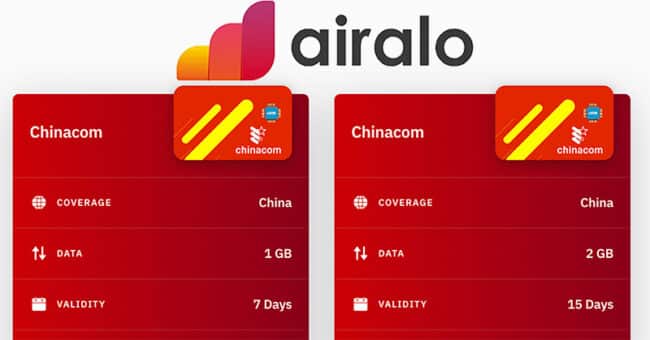


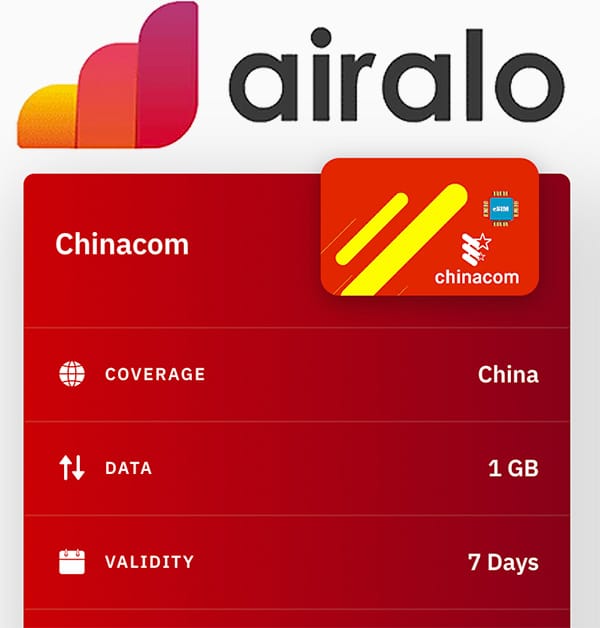




Hey Brian, the link for 3G Solutions in the article allows you to order a SIM card in the USA. They also have a listing on Amazon, if you’d rather order through Amazon: https://amzn.to/2SvmGY7
Hi, is it possible to connect to my iphone (personal hotspot) with USB cable to use my phone data for my laptop when in china with a local unicom sim?
I was able to do it with China Unicom, but I’m not sure whether that’s a specific phone plan. You’ll want to ask as you’re setting up your plan.
Hey Josh, timely article! i have been in anshan for a week. my china unicom sim card expired while i was back in florida. i will visit a china unicom store today to rectify the problem. I am heading to yingkou tomorrow for two weeks. then i fly from there to xi’an for a week. back to yingkou after that; return to Panama City beach on april 16th.
I really appreciate your articles. by the way, due to your recommendation, i have a 15-month subscription with express vpn. i am very satisfied with their service.
thanks again!
Awesome, John! So glad it’s worked out and I wish you safe travels 🙂
Thanks Josh, suggestions for 4g also(iphone x) Guangzhou,hk?
Hi Josh,
This is a good read. I will be in beijing next month for a vacation.
I am from the Philippines. I will be arriving Beijing by 1AM.
I would like to know if the stores will be open by that timeto get a sim card?
Based on the willmyphone work link (thanks for the insight btw), my phone can be supported only by China Unicom.
If the stores will already be closed by that time, what are my options?
Any help would be appreciated.
Thanks!
Hey Well, unfortunately all the shops, including those in the Beijing airport that might sell SIM cards, have already closed by 1am. You only have two options: 1) pre-purchase your SIM card using the 3G Solutions link in this article or 2) wait until the morning to get a SIM card. I recommend saving time by pre-purchasing.
Where to buy chinese sim card in Toronto? Thanks
If you live in the U.S., get a Google fi account. I have traveled to china 6 times and get good data service (LTE) from both China Telecom and China Unicom. Data costs $10/GB and is free over $60. The phone line costs $20/month and calls are $0.20/min or free over wifi. Google gets the service through T-Mobile, but for Google it is running at full speed. The great advantage is that you can be reached through your US number and that the service works in almost every country. It used to be that you needed a Google phone, but now a lot of other phones work with it too. I personally have the original Pixel XL from 2016 and it has an amazing camera. Only $120 used on eBay.
Hi Josh,
We arrived this morning in urumqi from Brazil. We are trying to BUy prepaid Chinese SIM cards, but people say we can’t do it in XINJIANG with a foreign passport. Is that right?
Hi Josh,
thanks for the useful information. when I get a Chinese sim card, will it be in English, I am not tech savvy
So we will be able to buy chinese sim card using a passport? When i tried that in winter of 2017 in China they told me only chinese ID is accepted
Yes, you can use a passport, although often you have to go to a main telecom office, not a smaller one.
do you know which terminal in beijing’s airport sells sim cards? is there a store outside the baggage claim area?
All of the terminals should sell them now in Beijing and Shanghai. You’ll see a kiosk near the baggage claim area.
Do I need a China sim card if I can use Verizon’s travel pass?
No, you don’t need a China SIM card in that case.
Hello,
Thanks for the helping article. I’m going to be TRAVELING to china very soon and i Was cUstOmizing my sim card through the “explore 3G solutions” link, but I wanted to double check if it was a good idea to get a sim card only with data (GB + VPN). So i suppose my questions are: 1) do I need the national calls and texts option or can i Get by wIth just my data? ,2) Does the VPN added as part of the package aCtually work or should i buy it SEPARATELY from VPN eXpress??
I would greatly appreciate your feeDback as soon as Possible. Thank you!
Great questions. Getting a local phone number allows you to receive texts, which in many cases helps if you want to use WiFi around China. Otherwise, you can do fine with just data.
As for the VPN, I recommend getting your own VPN (like ExpressVPN, separate from the SIM card company.
Hi josh!
Thanks for the wonderful insights about sim cards. I would like to ask your suggestion if i should get A china mobile or china unicom sim? Im using samsung note 8. Which provider offers more stable data connection. Thank you and hope to hear from you
They’re both about the same, so it really depends on which is more convenient for you where you’re located.
I am not sure if this workS in china but i know it works in eUrope, mexico, and other asian COUNTRIES. I have magic jack with a usa number for our unit down south, it works with wifi or on a phone. It cost 19.95 a year. You can onlY call or text canada and usa.
Yes, there are a number of VoiP options available, but they don’t give you a Chinese phone number. You’d be surprised at how helpful this can be as you’re traveling around China.
Good read! But a few questions:
1. Will a data only sim card able to order didi? i.e. driver won’t be able to call you or text you. yes I can read and speak chinese.
2. The 2 local plans seem to be all monthly plans? Do they have a prepaid one-time only plan? Can I buy them in the gaungzhou airport?
That’s a good point, which is why I often recommend people get a Chinese SIM card instead of using their international roaming. You need a phone number in order to use DiDi.
As for local plans, they all seem to be monthly plans. I don’t know that they do prepaid, one-time plans. And yes, there are SIM card kiosks at the Guangzhou airport 🙂
I have a China mobile SIM, on the 88rmb package. I constantly travel to China but was wondering how it works if let’s say the month finishes and I wait 15 days to recharge. Will that mean the next month of data starts when I recharge? Will I have to recharge every single month to keep using the number?
You need to keep recharging in order to keep the number.
Hi Josh, thanks for the very informative article. My question is: can I activate these prepaid sim cards to test and make sure everything works before going to China ? Or do I have to activate them after arriving in China ?
They’re active when you receive them, but they’re useless until you arrive in China. It would be pretty hard to test them, I would think.
Hey Josh,
Thanks for the great article! It is very useful.
Is the nationwide king plan still up? I’m planning on getting it at a China unicom store tomorrow. Thanks 🙂 Christophe
It should be! But if not (these things tend to change), you can usually find something comparable. They’ll show you what’s available when you arrive. Good luck!
Hi. I am Starting off in HK. There for 6 weeks before going to china for 4 months.
What do I do regarding sim card HK?
Thanks so much for taking the time to do this guideline and tips. It is extremely helpful and much appreciated .
My pleasure, Lee! Thankfully, it’s much easier to get a temporary SIM card in Hong Kong at the airport. You can get one that will work for 6 weeks (although, technically, your China SIM card will work in Hong Kong as well).
Hey josh, thanks for the article. Just wondering whether i need to head To a unicom store to purchase a sim or are there other retail outlets? Thanks, jess
If you’re already in China, I would go to a store. If you haven’t arrived yet and you’re only traveling through China, I would pre-purchase a SIM card to make things easier.